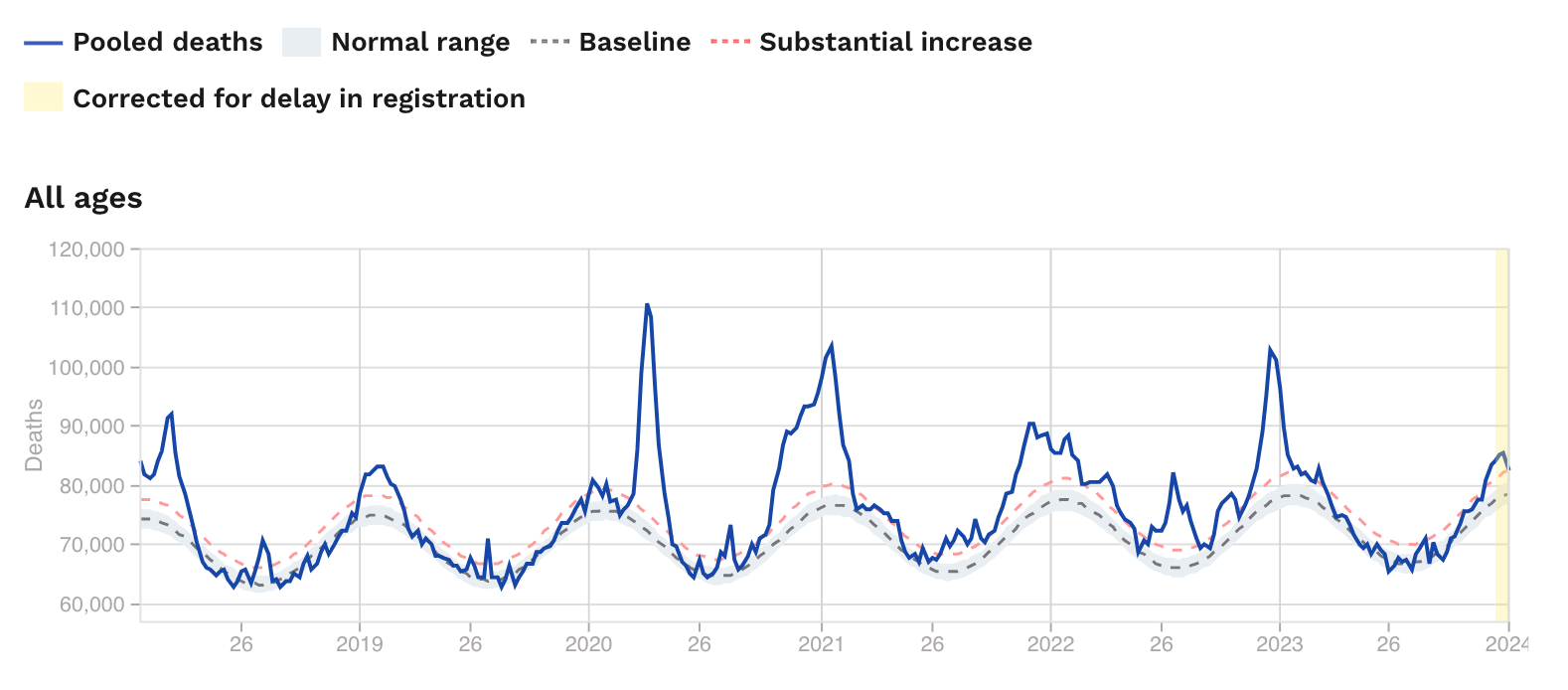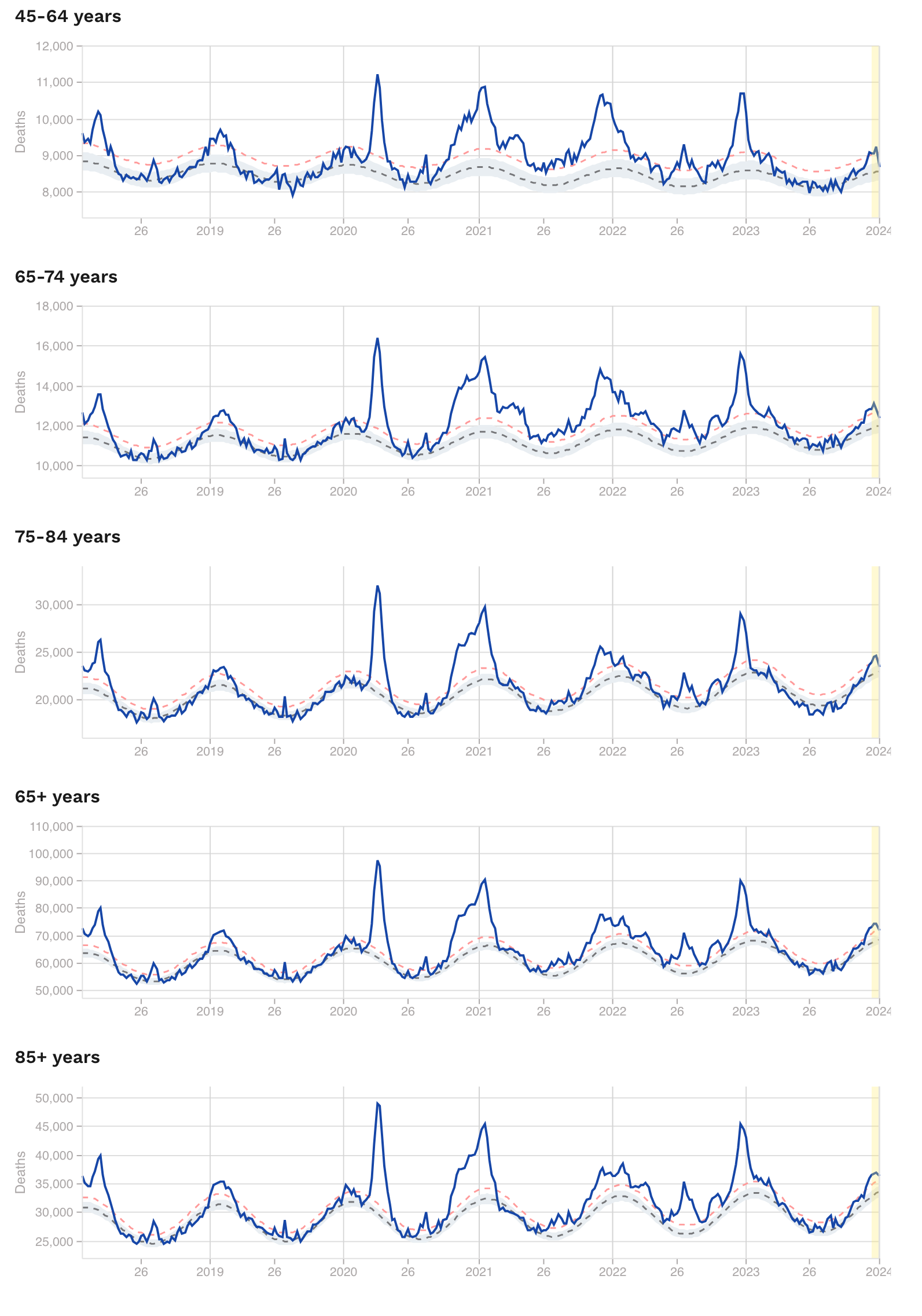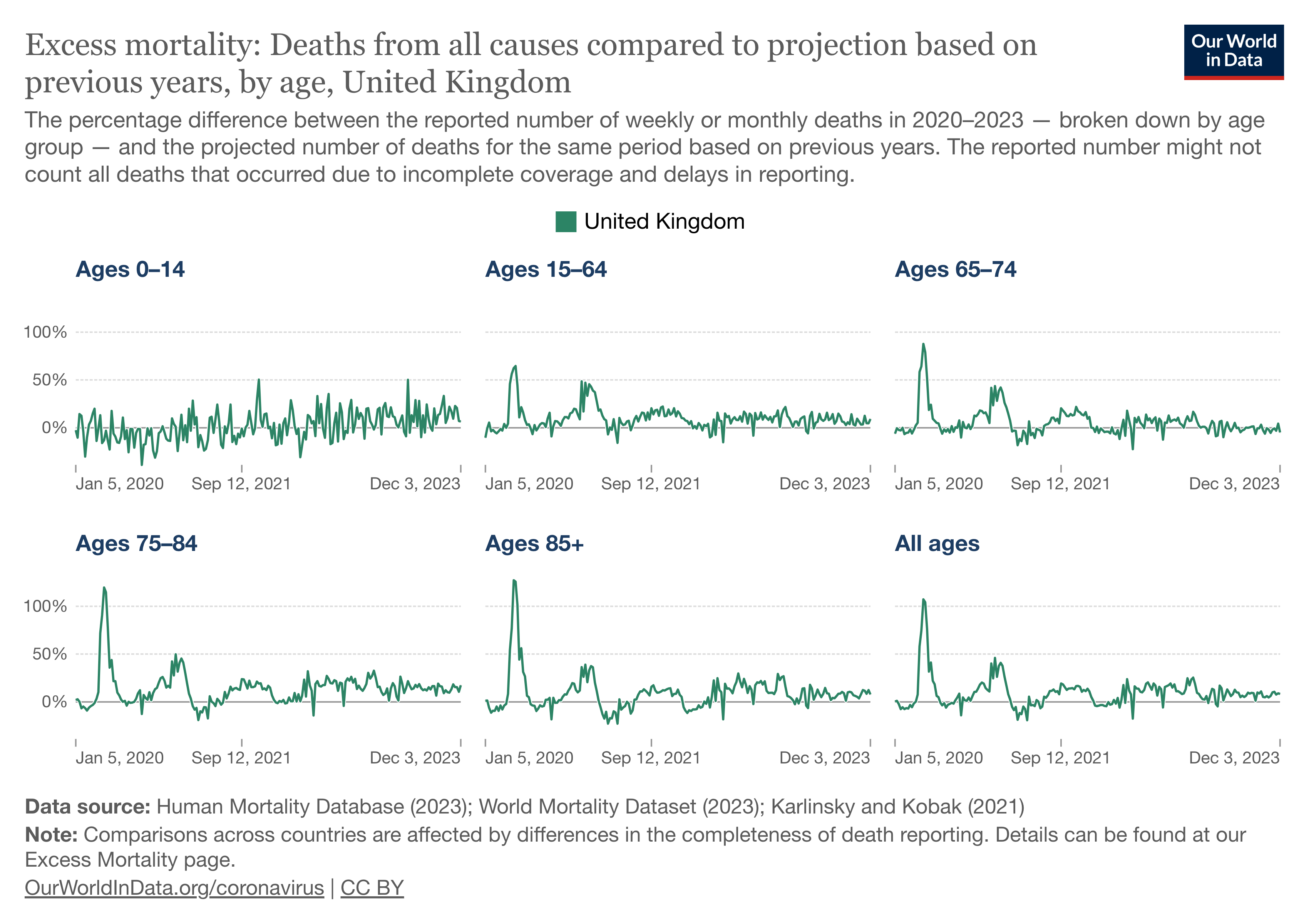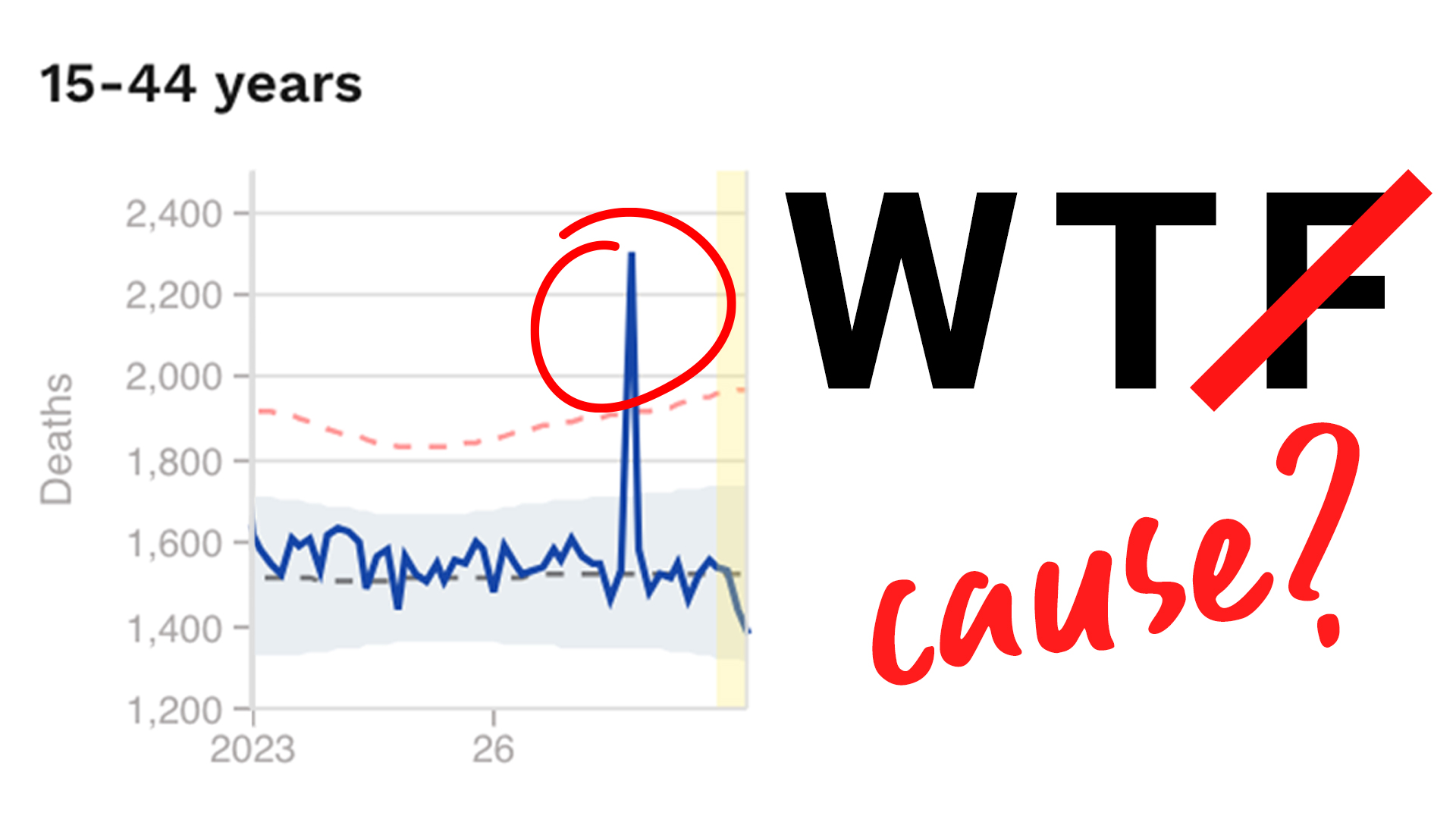Content Sections
By Rob Verkerk PhD, executive & scientific director, ANH-Intl and ANH-USA
Have you been noticing that more people appear to be dying or becoming critically ill of late? Many of us have, and it’s tragic when it’s close to home. And while we all recognise dying is an inevitable consequence of living, it is understanding the causes of changes in human population dynamics now as compared with our recent history that is of particular interest, given the frequency at which people are born and die dictates the size of the global population of humans. We’ll be bringing you in a future newsletter some of the latest insights from the other side of the coin, changes in fertility and birth rates, as that’s also of great concern.
Excess deaths – illusion or reality?
Excess deaths – the number of people dying compared with those expected to die – is a subject that’s coming up a lot in general discussion and in social media feeds. There seems to be two main reasons for the hype about it; one subjective, the other a little more objective.
The subjective part is down to many people having a perception of people they know, or know of, getting very sick particularly as a result of heart conditions or so-called ‘turbo’ cancers, or dying unexpectedly or more often than they might expect. So many people you talk to will comment on people close to them having recently become gravely ill or having died, often unexpectedly. News reports frequently inform us of the death of celebrities, many dying seemingly before their time.
But before we jump to conclusions, it’s time for a reality check. A truism is that our perception doesn’t necessarily reflect our reality, which is one of the reasons science exists so that observations can be evaluated and hypotheses tested. Most of us, for example, have never lived through a global pandemic – one in which millions were predicted of dying and ostensibly, according to official statistics, nearly 7 million across the world did pass on, at least in part, owing to infection by SARS-CoV-2.
You know that if you buy a yellow car, you suddenly become aware of just how many yellow cars there are on the roads, you having quietly ignored them before you acquired your own? It can be the same with your awareness of people getting sick and dying. We’ve all become hyper aware of people dying as a result of the pandemic, but we’ve also all become a few years older, so our cohort and everyone else on the planet has also become older so more prone to dying.
There are of course many possible reasons why people might be dying more frequently than expected. These could include delays in receiving diagnoses or treatments for serious diseases; a reduced tendency for people to visit physicians, clinics and hospitals; reduced trust of medical systems; persistent psychosocial stress; impacts of post-viral syndrome (e.g. long covid); impact of overweight, obesity and other chronic diseases; loss of immune system resilience; environmental exposure to toxicants or harmful electromagnetic fields, and/or; changes in lifestyles, diets or behaviour, especially among those already burdened with one or more chronic diseases. We know, for example from a study by an Italian team reviewing data from six countries on three different continents, there was a substantial increase in people having and dying of heart attacks outside hospital during the first wave of the pandemic than was the case prior to the pandemic.
The elephant in the room: genetic vaccines?
The above reasons aside, it is becoming ever more clear that the authorities have created a taboo that stretches between the public, through to the authorities themselves, to social media policies, and most reprehensibly, in my view, through a large part of the scientific community. This taboo is about completely ignoring the possible role of the global mass genetic vaccine program on excess mortality.
Like many others, we at ANH have faced intense internet and social media shadowbans because we’ve exercised freedom of speech in this area, as shown here, here and here.
We’ve also learned, for example from the Cleveland Clinic study, that receiving multiple genetic vaccines appears to actually increase our risk of covid disease, end-running the view promulgated widely by the likes of the World Health Organization (WHO), the US Centers for Control and Prevention of Disease (CDC), the UK Health Security Agency (formerly Public Health England) and other health authorities, that the genetic vaccines protect against disease.
When we look, scientifically, at the potential role of genetic vaccines, we see great uncertainty, part of this being the lack of sufficient focus on covid vaccine related short- and long-term harms by the mainstream scientific community. Centrally, it is essential to look not only at causes of disease or death that occur proximally with vaccination but also effects that are delayed, including those that result from disturbances to immune system function.
There is compelling evidence that the mass vaccination program, that has recently been given additional impetus by health authorities while Omicron continues to circulate and mutate under vaccine-induced selection pressure, is causing serious dysregulation of our immune systems. This problem appears to be most severe among those who are heavily vaccinated (i.e. having received multiple boosters or updated vaccines).
Mechanisms that caused immune dysregulation in the first generation of genetic vaccines unleashed at the end of 2020 included original antigenic sin that meant people who were vaccinated before they were naturally infected could not mount fully sterilising antibody responses to the circulating (Delta and Omicron, including the latest JN.1) variants as the spike protein of these differed significantly from the original strains of SARS-CoV-2 on which the vaccines were created. What we see instead is an enhancement of non-neutralising antibodies and more and more vaccine-breakthrough infections, as vaccinologist and ANH friend, Dr Geert Vanden Bossche, has championed for some time. Not only that, Geert warns that we now face a major challenge with steric immune refocusing (SIR) where the antibodies in vaccinated people start to target different and more conserved areas of the spike protein’s receptor-biding domain (RBD). This is the very ‘time bomb’ situation that the Belgian vaccinologist has long warned of — one in which the world continues to inch ever closer to, while more and more people try to grapple with new crises, ranging from a cost of living and energy crisis, European and Middle Eastern wars, environmental crises, and potential economic and political meltdowns.
With all of the above thoughts and hypotheses in our minds, let’s now take a look at some of the available excess mortality data from mainstream sources. It is our view that these sources are unlikely to over-state mortalities – which is one of the most robust measures as it’s somewhat tricky to hide deaths. That’s not to say there aren’t different ways or methods of measuring excess mortality, and critically it’s essential to know exactly what the reference data against which mortalities are being compared.
Excess mortality: data sources
There are some disturbing data emerging from a variety of sources that suggest this perception of excess mortality in 2023 (bearing in mind the end of the pandemic was declared by the WHO on 5 May 2023) is real, not illusory.
Below, we offer you links to 3 different perspectives and their sources with a short comment on each:
- PERSPECTIVE 1
Pearson-Stuttard et al, “Excess mortality in England post COVID-19 pandemic: implications for secondary prevention”, The Lancet, January 2024; 26: 100802.
This is a comment in The Lancet on excess mortalities in England. Data are cited from three different sources, the UK Office for National Statistics (ONS) (for the 2022 data the reference population is the 5-year average 2016 through 2021, excluding 2020), the Continuous Mortality Investigation (reference mortality was 2019) (CMI), and the Office for Health Improvement and Disparities (OHID). Deaths from covid in these data were any deaths in which covid-19 was mentioned on the death certificate, although this is irrelevant to excess mortality from any cause. All point to significant excesses, the ONS data showing a 7.2% higher than expected rate of death, this increasing even further to 8.3% in the first 6 months of 2023 (the limit of the available data). The figures were very similar for the CMI (28,500 excess deaths) for the first 6 months of 2023. But that wasn’t the biggest revelation. The OHID data found that excess deaths were relatively greatest among the middle-aged (50-64 year olds), being 15% higher than expected, while still being much higher than expected for 25-49 year olds and under 25s (11%) and 9% higher for the over-65s.
What’s clear, is that covid (on the death certificate) wasn’t a significant contributory factor to deaths in the 13 months from June 2022. Nearly half the excess deaths were the result of heart attacks and heart disease, including heart failure (↑47%), with other contributors being liver disease (↑19%), acute respiratory (non-covid) infections (↑14%) and diabetes (↑13%).
While cardiovascular causes of deaths among the middle-aged was one of the stand-out features of the OHID data, deaths in this age group from heart attacks, strokes and heart failure were 44%, 40% and 39% higher than the 5 years previous (excluding 2020). These numbers are massive in anyone’s book, but of course are compared only to the pre-pandemic year of 2019. Not only that, in the same 13 month period from June 2022, 22% more people died in homes and only 10% more in hospitals. Why, we might ask? Is there less trust placed in hospitals or are people dying from heart diseases so suddenly, there’s insufficient time to get to hospital? Or both?
Commenting in the BMJ on the ONS and OHID data back in October 2022, senior fellow Dr Veena Raleigh from the King’s Fund, suggests elevated deaths in the summer of 2022 could have been related to the heatwave (middle-aged and younger people, really?!), while covid-19 remained the sixth leading cause of death (despite it only being associated) and delayed or lack of care from an over-stretched National Health Service (NHS) was likely important.
The ONS data that included information on vaccination status until it no longer didn’t on 31 May 2023 when the pandemic was declared over by the WHO, despite covid still circulating and vaccines still being available, has been fraught with statistical problems that appear to have been deliberately or accidentally skewed by transposing deaths among the vaccinated on the unvaccinated. - PERSPECTIVE 2
EuroMOMO
This is a project originally set up by the European Commission’s DG Sanco (now DG SANTE) that was originally set up in 2008 to look at trends in influenza deaths (including swine flu), and is now managed through the European Centre for Disease Prevention and Control and the WHO, being hosted by Denmark. It takes official mortality data from 29 European countries and calculates excess mortalities using a Poisson model and algorithm developed in 2011, based on the Serfling method from 1963. EuroMOMO also calculates a statistic called a z-score to allow comparison of excess mortality by country. It uses a ‘three-week rule’ to ensure elevated mortality is real and not anomalous, being characterised as a “substantial increase” (i.e. peaks over dotted red lines on graphs).
Bearing in mind these data are collated from 29 different countries, excess deaths across all ages compared with the 5-year pre-pandemic era over the winter of 2023 is unexpected (Fig. 1), especially given the 2022 winter excess mortalities across the EuroMOMO partners had dropped to approximate the 2018 and 2019 levels.

Figure 1. Excess deaths for all ages in EuroMOMO 29 country dataset. Source: EuroMOMO.
- This 2023 winter peak is close to the peaks during the first two key pandemic years of 2020 and 2021 (Fig. 1). Like the UK data, there are some disturbing peaks across all ages, including the youngest age group, 15 to 44 years, which shows a peak in late 2023 that is entirely missing in any previous year, including during the March 2020 to May 2023 ‘pandemic’ period (Figure 2).

Figure 2. Excess deaths for 15-44 year age group in EuroMOMO 29 country dataset. Source: EuroMOMO.
- In the older age groups, the same winter 2022/23 peaks are seen (Fig. 3), these all contributing to the pattern seen across all ages (Fig. 1). Again, the early 2023 peak is not dissimilar to those of the early pandemic years of 2020 and 2021.

Figure 3. Excess deaths for age classes between 45 years and over 85 years in EuroMOMO 29 country dataset. Source: EuroMOMO.
- When the z-scores are compared across countries, this trend can be seen across the majority, and is most pronounced in Germany.
- PERSPECTIVE 3
Our World in Data
Our World in Data is a project of the UK charity, Global Change Data Lab, that originated from the work of Dr Max Roser in 2011 who is professor of Practice in Global Data Analytics at the Blavatnik School of Government at the University of Oxford. One of the primary funders of Our World in Data is the Gates Foundation that committed $1.5 million in 2021.
Our World in Data use a different and simpler model, deriving a P-score based simply on the percentage difference between reported and projected number of deaths.
Focusing on the UK, given we’ve looked at the UK data in some detail in Perspective 1 above, and also because UK data are known to be more comprehensive than most, we continue to see disturbing trends in excess mortality (i.e. greater than 0%) for 2023. While excess mortalities during the first wave of the pandemic are understandably high, the persistent elevation of excess mortality to the end of 2023 in all age groups, least of all among the 65-74 year group that had high vulnerability to covid, is highly noteworthy (Fig. 4).

Figure 4. Excess mortality in the UK across various age groups, based on P-scores. Source: Our World in Data.
What conclusions can we draw?
As I appraise these data, recognising the propensity for them to hide a lot of detail and for them to include inaccuracies given differences in timing of reported deaths in different countries, I am drawn to make two overwhelming conclusions.
First, there appears to be a very real — not an imaginary — increase in excess deaths that was apparent throughout 2023 that is almost certainly ongoing into 2024 that is affecting younger people, not the older age groups that were most affected during the early, most lethal phase of the pandemic.
Second, there has been a consistent inability for any of the authors, funders or health authorities, that have been responsible for collating, analysing and publishing the excess mortality data considered here, to reflect on a much wider range of possible contributory factors. I have included in the final paragraph of the subheading ‘Excess deaths – illusion or reality?’ above, a partial list. Omitted from this list are somewhat spurious causes of death among the youngest, such as the ingestion of disinfectants and sterilizers.
Another observation that is being made by many people, including clinicians, is the spiralling rate of ‘turbo’ cancers. But we’re unable to analyse data on cancers from 2023 as these are always late in being placed into the public domain. But this is a key metric to be watching based on what is currently anecdotal evidence — as tragic as it is for the families and friends involved.
What is despicable, in my view, is the silence over the possible role of the genetic vaccines in these excess deaths. Such is the taboo that has been deliberately created, along with censorship, marginalisation and cancelling of any scientist or doctor who even questions the role of this new, synthetic biology vaccine platform.
As the public continues to be aware of people becoming critically ill and dying around them, trust in the scientific and medical establishment, as well as in health authorities and governments, will continue to be eroded. No wonder next week’s World Economic Forum (WEF) meeting is entitled “Rebuilding Trust”, following in the footsteps of the Nobel Prize Summit in Washington DC, “Truth, Trust and Hope”, last May.
Once the powers that be have woken up to the fact that the public is not as easily misled as they think and some sense of transparency and openness has been restored, perhaps rebuilding trust is a possibility. With around 50 countries, representing half the world’s population, facing elections in 2024, is this the best opportunity we’ve had for the people choosing who governs us?
This might give us a fairer chance to resolve some of our biggest challenges, such as how we manage our health, without manipulation and distortion by the incumbent corporatocracies controlled by Big Pharma, Big Tech and Big Chem and the network of billionaires who’re currently on their way to Davos.
To facilitate free expression in a heavily censored world, we ask that you please share this article widely with your friends, families and networks.
>>> If you’re not already signed up for the ANH International weekly newsletter, sign up for free now using the SUBSCRIBE button at the top of our website – or better still – become a Pathfinder member and join the ANH-Intl tribe to enjoy benefits unique to our members.
>> Feel free to republish - just follow our Alliance for Natural Health International Re-publishing Guidelines
>>> Return to ANH International homepage








Comments
your voice counts
13 January 2024 at 4:39 pm
Rob,
Ref: Excerpt from third last Paragraph - above:
facing elections in 2024, is this the best opportunity we’ve had for the people choosing who governs us?
Unless people get involved in the local political parties (or start up independent groups) there shall be little change to the usual offerings/Candidates who are "placed" on voting tickets on Election Day.
PRE-SELECTIONS can and have been rigged long ago, and often the Pre-selection C'tee barely know the Candidates presenting for Pre-Selection, often committees do not know the probing questions to ask and are too polite to really do in-depth research and long before the Pre-selection day.
Pre polling and Polling Day, The Public reads what the chosen Candidate and his C'tee have printed and away the same old Parties/thinking pattern goes on.
Of course loyal and limited thinking political party Members listen to the General Secretary or President of the various Local, State, Provinces, Boroughs political parties, who quite often do not have a solid knowledge base of Candidates history, or do and want that person in office so can and do rig the pre.selection in a number of ways.
ALSO, exposure of certain personality types, needs to be adequately observed and certain questions asked as Sociopaths and the more severe form of Psychopathic personality are drawn these days to Politics and by definition, these people embrace turning on the charm and manipulation of the people, and can be most convincing, but ALWAYS care for THEIR AGENDA. Plenty of examples of this for the last 30+++ years.
Its up to individuals to become ACTIVELY involved in their Party of choice to have a true effect in their Elections, and then keep doing their bit in their political partys' to let Politicians' KNOW they are answerable to their Electorate.
13 January 2024 at 5:46 pm
Ahhhh, excess deaths - no surprise there! During the alleged pandemic I refused to be impregnated with a cocktail of synthetic chemicals that my immune system (and other vital parts of my body) had never experienced before. I remember with amusement some third-rate celebrities appearing on UK Gov sponsored TV commercials, suggesting it was 'our duty' to get jabbed with a so called anti-viral vaccine that had not been subjected to long term safety and efficacy trials.
Since then I have seen a number of Coroner reports stating that young, previously healthy individuals who had suddenly passed away soon after being jabbed, almost certainly died from complications caused directly from the Covid vaccine. At age 77 and in perfect health, I prefer to focus on a nutrient-rich diet plus selected supplements including Liposome Vitamin D3 & Vitamin K2. Best in Health!
17 January 2024 at 12:19 pm
As another 77 year old who has survived two heart attacks, ALS/Motor Neuron Disease, 2 x malaria, infectious hep and others, if it weren't for Rob and Meleni providing expert nutritional advice after extensive data analysis on blood and DNA, I wouldn't be writing this additional positive recommendation of their approach.
14 January 2024 at 11:07 am
A powerful and accurate summery backed by extensive research, which will hopefully get more people thinking...and inspire them to be well-informed guardians of their health moving forward! :)
16 January 2024 at 6:49 pm
Staying with my daughter over the weekend we were introduced to TV program Traitors - a group of people trying to work out which in the group are "faithful" and which are the traitors. Reminded me of the last few years. But then to counterbalance this we watched (under sufferance) the Barbie movie. This gave me hope as all the Barbies wake up from their stupor and begin to actually THINK!! Unfortunately I still think the majority are asleep to any of the above and would still be in the faithful group.
Your voice counts
We welcome your comments and are very interested in your point of view, but we ask that you keep them relevant to the article, that they be civil and without commercial links. All comments are moderated prior to being published. We reserve the right to edit or not publish comments that we consider abusive or offensive.
There is extra content here from a third party provider. You will be unable to see this content unless you agree to allow Content Cookies. Cookie Preferences